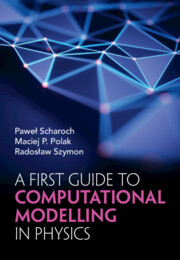Refine search
Actions for selected content:
3190 results in Mathematical Methods
Project 10: - The Fermi–Pasta–Ulam–Tsingou Problem
-
- Book:
- A First Guide to Computational Modelling in Physics
- Published online:
- 01 February 2024
- Print publication:
- 08 February 2024, pp 64-71
-
- Chapter
- Export citation
Project 1: - Rectangular Finite Quantum Well – Stationary Schrödinger Equation in 1D
-
- Book:
- A First Guide to Computational Modelling in Physics
- Published online:
- 01 February 2024
- Print publication:
- 08 February 2024, pp 1-6
-
- Chapter
-
- You have access
- Export citation
Project 12: - Rectangular Quantum Well Filled with Electrons – The Idea of Self-Consistent Calculations
-
- Book:
- A First Guide to Computational Modelling in Physics
- Published online:
- 01 February 2024
- Print publication:
- 08 February 2024, pp 78-80
-
- Chapter
- Export citation
Project 5: - Gravitation inside a Star
-
- Book:
- A First Guide to Computational Modelling in Physics
- Published online:
- 01 February 2024
- Print publication:
- 08 February 2024, pp 34-39
-
- Chapter
- Export citation
Project 6: - Normal Modes in a Cylindrical Waveguide
-
- Book:
- A First Guide to Computational Modelling in Physics
- Published online:
- 01 February 2024
- Print publication:
- 08 February 2024, pp 40-44
-
- Chapter
- Export citation
Project 7: - Thermal Insulation Properties of a Wall
-
- Book:
- A First Guide to Computational Modelling in Physics
- Published online:
- 01 February 2024
- Print publication:
- 08 February 2024, pp 45-51
-
- Chapter
- Export citation
Index
-
- Book:
- A First Guide to Computational Modelling in Physics
- Published online:
- 01 February 2024
- Print publication:
- 08 February 2024, pp 108-110
-
- Chapter
- Export citation
Project 13: - Time Dependent Schrödinger Equation
-
- Book:
- A First Guide to Computational Modelling in Physics
- Published online:
- 01 February 2024
- Print publication:
- 08 February 2024, pp 81-85
-
- Chapter
- Export citation
Preface
-
- Book:
- A First Guide to Computational Modelling in Physics
- Published online:
- 01 February 2024
- Print publication:
- 08 February 2024, pp ix-xi
-
- Chapter
- Export citation
Contents
-
- Book:
- A First Guide to Computational Modelling in Physics
- Published online:
- 01 February 2024
- Print publication:
- 08 February 2024, pp v-viii
-
- Chapter
- Export citation
Project 2: - Diffraction of Light on a Slit
-
- Book:
- A First Guide to Computational Modelling in Physics
- Published online:
- 01 February 2024
- Print publication:
- 08 February 2024, pp 7-17
-
- Chapter
- Export citation
Advanced Projects
-
- Book:
- A First Guide to Computational Modelling in Physics
- Published online:
- 01 February 2024
- Print publication:
- 08 February 2024, pp 57-57
-
- Chapter
- Export citation
Project 11: - Hydrogen Star
-
- Book:
- A First Guide to Computational Modelling in Physics
- Published online:
- 01 February 2024
- Print publication:
- 08 February 2024, pp 72-77
-
- Chapter
- Export citation
Project 14: - Poisson’s Equation in 2D
-
- Book:
- A First Guide to Computational Modelling in Physics
- Published online:
- 01 February 2024
- Print publication:
- 08 February 2024, pp 86-91
-
- Chapter
- Export citation
How to Use the Book
-
- Book:
- A First Guide to Computational Modelling in Physics
- Published online:
- 01 February 2024
- Print publication:
- 08 February 2024, pp xii-xiv
-
- Chapter
- Export citation
Appendix A: - Supplementary Materials
-
- Book:
- A First Guide to Computational Modelling in Physics
- Published online:
- 01 February 2024
- Print publication:
- 08 February 2024, pp 92-106
-
- Chapter
- Export citation

A First Guide to Computational Modelling in Physics
-
- Published online:
- 01 February 2024
- Print publication:
- 08 February 2024
Contents
-
- Book:
- Python for Chemists
- Published online:
- 12 October 2023
- Print publication:
- 26 October 2023, pp v-x
-
- Chapter
- Export citation
34 - Nonlinear Fitting and Constrained Optimization
-
- Book:
- Python for Chemists
- Published online:
- 12 October 2023
- Print publication:
- 26 October 2023, pp 378-396
-
- Chapter
- Export citation
23 - Vibrational Spectroscopy
-
- Book:
- Python for Chemists
- Published online:
- 12 October 2023
- Print publication:
- 26 October 2023, pp 260-266
-
- Chapter
- Export citation
